#State fossils
Text

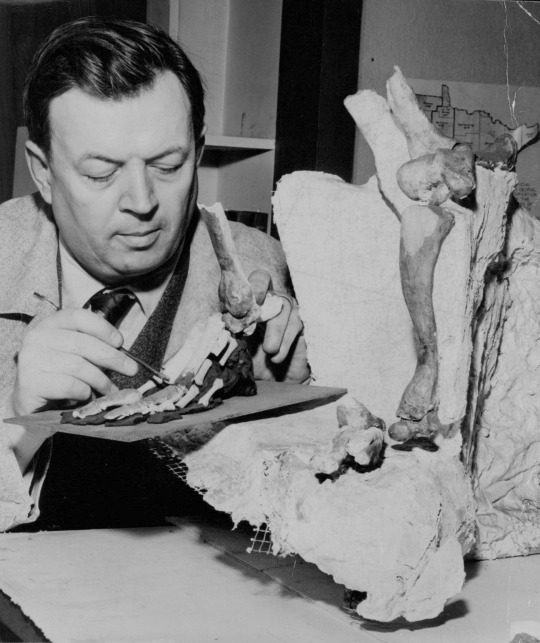
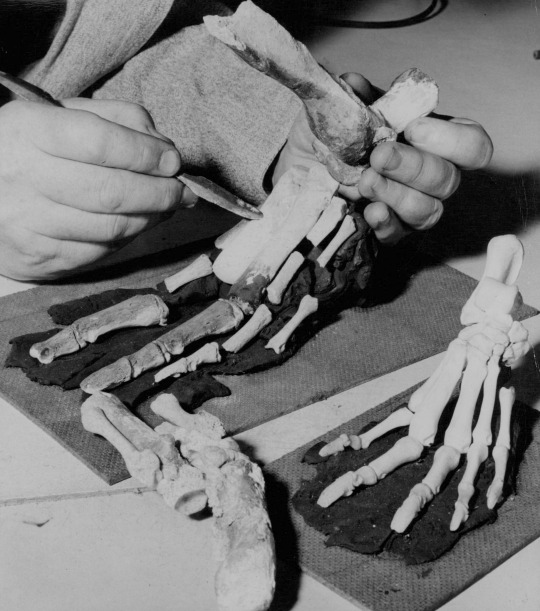
That's One Giant Beaver!
Giant beavers as big as bears (6 to 9 feet long, weighing 200-500 pounds) ranged the Mississippi River flats over 15,000 years ago. Picture here, in 1947, is Louis H. Powell, director of the Science Museum of St. Paul, comparing a giant beaver skull dug up on the Mississippi flats, near Hidden Falls park, with the skull of a large modern beaver.
In 2021, the Science Museum of Minnesota nominated a Giant Beaver specimen to be the official state fossil. You can read the campaign online. A bill was introduced in 2022.
Photos from the Minneapolis Newspaper Photograph Collection in the Hennepin County Library Digital Collections. The 1947 newspaper article which featured these photographs incorrectly stated that the fossil was dug up below the Lake Street Bridge, but Hidden Falls Park is in St. Paul.
#Minnesota#St. Paul#Mississippi River#Beavers#Fossils#Giant Beavers#State fossils#Science Museum of Minnesota#science#prehistoric animals#extinct animals
68 notes
·
View notes
Text
No paywall version here.
"Two and a half years ago, when I was asked to help write the most authoritative report on climate change in the United States, I hesitated...
In the end, I said yes, but reluctantly. Frankly, I was sick of admonishing people about how bad things could get. Scientists have raised the alarm over and over again, and still the temperature rises. Extreme events like heat waves, floods and droughts are becoming more severe and frequent, exactly as we predicted they would. We were proved right. It didn’t seem to matter.
Our report, which was released on Tuesday, contains more dire warnings. There are plenty of new reasons for despair. Thanks to recent scientific advances, we can now link climate change to specific extreme weather disasters, and we have a better understanding of how the feedback loops in the climate system can make warming even worse. We can also now more confidently forecast catastrophic outcomes if global emissions continue on their current trajectory.
But to me, the most surprising new finding in the Fifth National Climate Assessment is this: There has been genuine progress, too.
I’m used to mind-boggling numbers, and there are many of them in this report. Human beings have put about 1.6 trillion tons of carbon in the atmosphere since the Industrial Revolution — more than the weight of every living thing on Earth combined. But as we wrote the report, I learned other, even more mind-boggling numbers. In the last decade, the cost of wind energy has declined by 70 percent and solar has declined 90 percent. Renewables now make up 80 percent of new electricity generation capacity. Our country’s greenhouse gas emissions are falling, even as our G.D.P. and population grow.
In the report, we were tasked with projecting future climate change. We showed what the United States would look like if the world warms by 2 degrees Celsius. It wasn’t a pretty picture: more heat waves, more uncomfortably hot nights, more downpours, more droughts. If greenhouse emissions continue to rise, we could reach that point in the next couple of decades. If they fall a little, maybe we can stave it off until the middle of the century. But our findings also offered a glimmer of hope: If emissions fall dramatically, as the report suggested they could, we may never reach 2 degrees Celsius at all.
For the first time in my career, I felt something strange: optimism.
And that simple realization was enough to convince me that releasing yet another climate report was worthwhile.
Something has changed in the United States, and not just the climate. State, local and tribal governments all around the country have begun to take action. Some politicians now actually campaign on climate change, instead of ignoring or lying about it. Congress passed federal climate legislation — something I’d long regarded as impossible — in 2022 as we turned in the first draft.
[Note: She's talking about the Inflation Reduction Act and the Infrastructure Act, which despite the names were the two biggest climate packages passed in US history. And their passage in mid 2022 was a big turning point: that's when, for the first time in decades, a lot of scientists started looking at the numbers - esp the ones that would come from the IRA's funding - and said "Wait, holy shit, we have an actual chance."]
And while the report stresses the urgency of limiting warming to prevent terrible risks, it has a new message, too: We can do this. We now know how to make the dramatic emissions cuts we’d need to limit warming, and it’s very possible to do this in a way that’s sustainable, healthy and fair.
The conversation has moved on, and the role of scientists has changed. We’re not just warning of danger anymore. We’re showing the way to safety.
I was wrong about those previous reports: They did matter, after all. While climate scientists were warning the world of disaster, a small army of scientists, engineers, policymakers and others were getting to work. These first responders have helped move us toward our climate goals. Our warnings did their job.
To limit global warming, we need many more people to get on board... We need to reach those who haven’t yet been moved by our warnings. I’m not talking about the fossil fuel industry here; nor do I particularly care about winning over the small but noisy group of committed climate deniers. But I believe we can reach the many people whose eyes glaze over when they hear yet another dire warning or see another report like the one we just published.
The reason is that now, we have a better story to tell. The evidence is clear: Responding to climate change will not only create a better world for our children and grandchildren, but it will also make the world better for us right now.
Eliminating the sources of greenhouse gas emissions will make our air and water cleaner, our economy stronger and our quality of life better. It could save hundreds of thousands or even millions of lives across the country through air quality benefits alone. Using land more wisely can both limit climate change and protect biodiversity. Climate change most strongly affects communities that get a raw deal in our society: people with low incomes, people of color, children and the elderly. And climate action can be an opportunity to redress legacies of racism, neglect and injustice.
I could still tell you scary stories about a future ravaged by climate change, and they’d be true, at least on the trajectory we’re currently on. But it’s also true that we have a once-in-human-history chance not only to prevent the worst effects but also to make the world better right now. It would be a shame to squander this opportunity. So I don’t just want to talk about the problems anymore. I want to talk about the solutions. Consider this your last warning from me."
-via New York Times. Opinion essay by leading climate scientist Kate Marvel. November 18, 2023.
#WE CAN DO THIS#I SO TRULY BELIEVE THAT WE CAN DO THIS#WE CAN SAVE OURSELVES AND THE WORLD ALONG WITH US#climate crisis#united states#climate change#conservation#hope posting#sustainability#climate news#climate action#climate emergency#fossil fuels#global warming#environmentalism#climate hope#solarpunk#climate optimism#climate policy#earth#science#climate science#meteorology#extreme weather#renewable energy#solar power#wind power#renewables#carbon emissions#climate justice
33K notes
·
View notes
Text
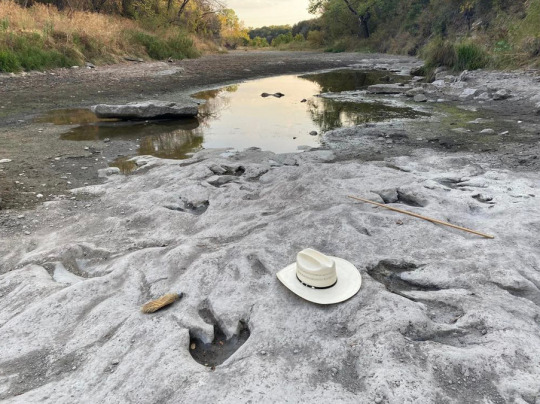
[ Some of the approximately 75 dinosaur tracks discovered at the site. Photo courtesy of Paul Baker / Friends of Dinosaur Valley State Park. ]
"Drought has dried up part of a river in central Texas, revealing 113-million-year-old dinosaur tracks.
The prehistoric footprints emerged at Dinosaur Valley State Park, which is located in the town of Glen Rose, southwest of the Dallas-Fort Worth area.
As the name suggests, the park already protects other dinosaur footprints. But the tracks that recently emerged are usually hidden under the mud, silt and waters of the Paluxy River. This summer, however, water levels have dipped so low that the prehistoric indentations are now visible. So far, volunteers have counted 75 newly exposed footprints in the parched riverbed.
“It has been another very hot, very dry year, so our researchers are trying to take advantage of the drought,” says park superintendent Jeff Davis to the Dallas Morning News’ Sarah Bahari.
Two different types of dinosaurs likely made the footprints, according to park officials. One was Acrocanthosaurus, a 15-foot-tall carnivore that weighed approximately 14,000 pounds. As the gargantuan reptile walked around the area on two legs, it left behind the outline of its three-toed feet. The other was Sauroposeidon proteles, which has been the official state dinosaur of Texas since 2009. This long-necked behemoth may have measured up to 100 feet long and weighed closer to 88,000 pounds. It left behind larger, bulbous-shaped tracks that are similar to elephant footprints."
Read more: "Drought Reveals 113-Million-Year-Old Dinosaur Tracks in Texas" by Sarah Kuta.
#palaeoblr#Dinosaur Valley State Park#Texas#Acrocanthosaurus#Sauroposeidon#Dinosaurs#Cretaceous#Mesozoic#Prehistoric#Extinct#Theropod#Sauropod#Sauroposeidon proteles#Trace fossil#Article#Photo
280 notes
·
View notes
Text
During the socialist state period in Hungary, for example, widespread soil acidification problems are traceable to heavy use of agrochemicals, like ammoniacal nitrate, but the problem could have been averted or at least reduced by refraining from producing the likes of sausages, fruits and vegetables for Western markets, especially West Germany and Austria, to fulfil loan repayment schedules imposed by Western financial institutions. In effect, the more an economy is integrated with international capital flows, the higher the ecological footprint. Accordingly, China, as a country embodying the main contradictions of the world capitalist economy, should be expected to have a worsening environmental record. As Peters et al. have shown, the wealthiest countries (largely liberal democracies) can overconsume fossil fuels and spew out the most greenhouse gases by appropriating natural wealth (e.g. fossil fuels) from the rest of the world, where there is chronic underconsumption relative to fossil fuel production.
Salvatore Engel-Di Mauro, Socialist States and the Environment: Lessons for Eco-Socialist Futures
67 notes
·
View notes
Text
Don't forget the reason the U.S. is supporting Israel's genocide of Palestine - hell, 90% of the reason they ever get involved into something in the Middle East is for ulterior purposes regarding oil.


That and the Ben Gurion Canal project, which you can learn more about:
Also this short video explaining the canal's significance and full history in summary:
Simply put,

#free palestine#israel is a genocidal state#israel is a terrorist state#fuck america#fuck israel#comic pic is from persepolis btw#which is an autobiography of the author growing up in iran during the iranian revolution#not to mention how the US destabilized iran bc their democratically elected leader was gonna nationalize its oil for iran#and they put someone who would play ball for them in charge#its always about the oil#EVEN IN THE MIDST OF EVERYONE GOING “THE FUTURE ISNT VIABLE W FOSSIL FUELS”#WE SHOULD BE LOOKING FORWARD FOR USING AND TRANSITIONING TO RENEWABLE ENERGY SOURCES#BUT THE CAPITALISTIC FUCKS WANT MONEY NOW#AT THE EXPENSE OF HUMAN LIVES#THE LIVES OF ARABS AND BROWN PPL INDIGENOUS TO PALESTINE NOTE THAT#aaaaaaand of course the canal#much easier than dealing w egypt#for both israel and america#israel will be onboard w them and they'll have a way of strengthening their grip on the middle east and world economy#this is honestly disgusting and terrifying#egypt#suez canal
62 notes
·
View notes
Text
A team of scientists has discovered a new fossil shark species from Alabama. The shark is a new species of Palaeohypotodus, which means "ancient small-eared tooth," in reference to the small needle-like fangs present on the sides of the teeth.
It has been named Palaeohypotodus bizzocoi, for the late Dr. Bruce Bizzoco (1949–2022) of Birmingham, Alabama. Bizzoco served as a Dean at Shelton State Community College, archaeologist, and was a longtime volunteer at McWane Science Center. The naming of this species honors Dr. Bizzoco's lifelong commitment to education and the preservation of Alabama's history.
Continue Reading.
50 notes
·
View notes
Text

I’m late to this sorry
#I HAJVE GOOD REASON OKAY#I WAS OUT OF STATE VISITNG FAMILY FOR LUNAR NEW YEAR#anyway#objectified comic#objectified comic fanart#objectified fossil
28 notes
·
View notes
Text
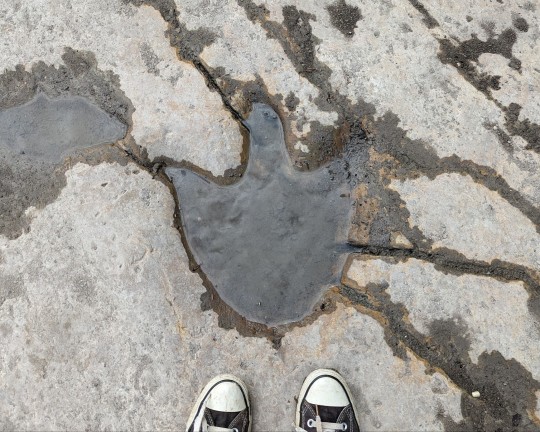
dinosaur valley state park
#mine#100#nature#nature blogger#nature blog#nature aesthetic#dinosaurs#dinosaur#dinosaurcore#fossil#geology#aesthetic#naturecore#rocks#animals#science#scienceblr#photography#dinosaur valley#dinosaur valley state park#texas#adventure#adventurecore#kidcore
217 notes
·
View notes
Text
Let’s make something quite clear.
COP29 is going to be nothing but a ghastly self-congratulatory circlejerk of genocidally minded fossil fuel worshippers and greenwashing nihilists furiously yanking eachother off amidst a backdrop of caviar and champagne.
Hosted by a genocidally minded petrodollar fascist dictatorship no less.
(To say nothing of Ukraine’s cynical support for such a putrid government! Talk about double standards!)
You know this.
I know this.
Everyone and their dog knows this.
Hosting the previous conference in Dubai was bad enough but this is genuinely obscene!
It’s beyond insulting.
Boycott the shite out of it.
Or at least call it out.
Perhaps both! Idk.
Feel free to reblog.
Leaving a few more news articles and other relevant links here too for clarity.
Some of them are a few months out of date (mostly from very late last year) admittedly but it took me a while to find them.
Reblog the shit out of this.
#dougie rambles#personal stuff#environmentalism#greenwashing#cop29#azerbaijan#Baku#fuck Azerbaijan#war crimes#terrorism#azerbaijan is a terrorist state#caucasus#europe#Azerbaijan is a rogue state#turkey#fuck Erdogan#fossil fuels#oil#gas#lies#bullshit#boycott#boycott Azerbaijan#political crap#vent post#reblog this#reblog the shit out of this#feel free to reblog#ecology#climate change
23 notes
·
View notes
Text
"There is a small panel of regulators in every state that holds a similar power over electricity generation and, by extension, an enormous segment of the United States’ greenhouse gas emissions that are warming the planet. By setting electricity prices, they also have a substantial impact on most people’s lives and pocketbooks. Yet, in Georgia and elsewhere, these groups — known as public service or public utility commissions — get little attention or scrutiny outside of energy wonk circles. Their hearings and documents tend to be long and jargon-heavy, covered in the media by a small group of specialized reporters, making it hard to engage with the process.
This year, Grist and WABE will try to demystify energy regulation in Georgia and beyond. We’ll bring you stories on not only how your power gets made, but how those decisions happen — and how residents who vote and pay electricity bills can get involved."
-via Grist, March 5, 2024. See link for more details (especially in Georgia) and more ways to get involved.
#clean energy#green energy#renewable energy#climate crisis#fossil fuels#elected officials#2024 elections#us election#united states#us politics#state politics#georgia#solar power#wind power#utilities#activism#climate activism#organizing#action post#hope
18 notes
·
View notes
Text
By Oliver Milman
The Guardian
July 5, 2023
Allstate, too, has pulled out of climate disaster-prone areas while hiring lobbyists who are also aligned to fossil fuel interests
The largest home insurer in the US, State Farm, which is halting new homeowner policies in California due to the “rapidly growing catastrophe exposure” posed by wildfires, has hired lobbyists who also work to advance fossil fuel industry interests across 18 states, a new database shows.
While State Farm in May refused to take new home insurance applications in California, it retains a lobbying firm in the state – the Sacramento-based KP Public Affairs – which also represents Tenaska, a gas developer. Across the US, State Farm shares lobbyists with a raft of oil and gas companies, including ExxonMobil, Calpine and Occidental Energy.
Allstate, another insurer that followed State Farm in pulling out from new policies in California due to the state’s worsening wildfire risk, has also contracted lobbyists who have fossil fuel clients, such as Chevron, ConocoPhillips and Kinder Morgan.
State Farm and Allstate are just two of more than 150 insurance companies and associations – part of an industry facing steepening losses from fires, floods and other disasters spurred by the climate crisis – that use state-based lobbyists also aligned to fossil fuel interests, according to F Minus, a new database of public disclosure records.
James Browning, executive director of F Minus, said that State Farm’s linkage to fossil fuels stretches to Florida, where its lobbying firm Dean Mead also represents the Williams Companies, a gas pipeline operator in the state. “This allegiance with gas interests clearly pits State Farm against the interests of its customers as they face increasingly severe hurricanes, floods, and soaring insurance costs,” said Browning.
The lobbying overlap between insurers like State Farm and the fossil fuel companies stoking the climate crisis is “problematic and potentially counterproductive”, according to Tom Corringham, a research economist with the Scripps Institution of Oceanography at the University of California, San Diego.
Insurers and fossil fuel companies could be working at cross-purposes around issues such as climate risk disclosures, he said, which the insurance industry requires to accurately price risk for homes facing a rising threat of flooding or fire.
Read more.
62 notes
·
View notes
Text
"Governor Janet Mills announced that Maine has, two years ahead of time, surpassed its goal of installing 100,000 new heat pumps by 2025, a milestone that represents significant progress in reducing Maine’s reliance on heating oil, lowering heating costs, and curbing harmful carbon emissions.
To continue Maine’s momentum, Governor Mills also unveiled a new target: installing another 175,000 additional heat pumps in Maine by 2027, thereby bringing the number of heat pumps installed in Maine homes, businesses, and public buildings during her time in office to 275,000.
If this target is achieved, Maine would have more than 320,000 heat pumps in total installed across the state.
Heat pumps can be thought of as temperature recycling machines. They are filled with refrigerant fluid and contain a compressor, and they work by extracting excess heat and moving it around, either in or out of a house depending on whether it’s hot or cold.
It’s believed they work best in hot weather, but in February, Maine’s temperatures in some places plummeted during a cold snap to -60°F. Efficiency Maine, which aided in the state’s adoption of heat pumps by organizing rebates for customers under the provisions of the Inflation Reduction Act, did a survey of owners they had helped the previous year.
Many of [the heat pump owners] reported they were comfortable and warm, and offered to bring up the fact that by February they had already saved hundreds of dollars on home heating systems, over boilers, gas furnaces, and heating oil.
“We are setting an example for the nation,” said Mills at the announcement event. “Our transition to heat pumps is… curbing our reliance on fossil fuels, and cutting costs for Maine families, all while making them more comfortable in their homes—a hat trick for our state.”
The transition began in 2019 with bipartisan support of the Legislature, when Governor Mills enacted laws setting ambitious targets for transitioning to renewable energy and reducing greenhouse gas emissions."
-via Good News Network, July 31, 2023
#maine#united states#us politics#heat pump#fossil fuels#carbon emissions#climate crisis#refrigerant#heating and cooling#air conditioning#heater#cold snap#good news#hope#hope posting#janet mills
3K notes
·
View notes
Text
Fossil Friday: Utahraptor!

Remember this chimera? So, it may not be a real Velociraptor but there was a real dromaeosaur this size. It's called Utahraptor and it lived in, well, Utah during the early Cretaceous Period 135-130 million years ago.

It was found in the Cedar Mountain Formation near Moab in 1975 but it didn't get much recognition until 1991. There is currently a "Utahraptor block" that is in the process of being prepped out and has yielded remains of baby to adult Utahraptors (along with two iguanodontids).

Utahraptor is the state dinosaur of Utah and Utahraptor State Park was officially created in 2021 where the block was discovered.


16 notes
·
View notes
Text
Peruvian fossil challenges blue whales for size
3 August 2023

By Jonathan Amos, Science correspondent
Scientists have identified a new candidate for the heaviest ever animal on Planet Earth.
It's an ancient, long-extinct whale that would have tipped the scales at close to 200 tonnes.
Only some of the very biggest blue whale specimens might have rivalled its heft, researchers say.
The creature's fossilised bones were dug up in the desert in southern Peru, so it has been given the name Perucetus colossus.
Dating of the sediments around the remains suggests it lived about 39 million years ago.
"The fossils were actually discovered 13 years ago, but their size and shape meant it took three years just to get them to Lima (the capital of Peru), where they've been studied ever since," said Dr Eli Amson, a co-worker on the discovery team led by palaeontologist Dr Mario Urbina.

Eighteen bones were recovered from the marine mammal - an early type of whale known as a basilosaurid.
These included 13 vertebrae, four ribs and part of a hip bone.
But even given these fragmentary elements and their age, scientists were still able to decipher a huge amount about the creature.
In particular, it's evident the bones were extremely dense, caused by a process known as osteosclerosis in which inner cavities are filled.
The bones were also oversized, in the sense they had extra growth on their exterior surfaces - something called pachyostosis.
These weren't features of disease, the team said, but rather adaptations that would have given this large whale the necessary buoyancy control when foraging in shallow waters.
Similar bone features are seen for example in modern-day manatees, or sea cows, which also inhabit coastal zones in certain parts of the world.
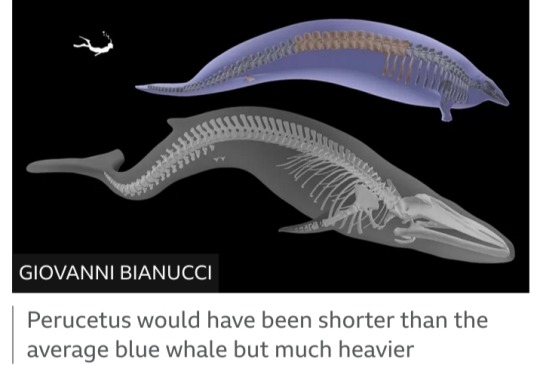
"Each vertebra weighs over 100kg, which is just completely mind-blowing," said co-worker Dr Rebecca Bennion from the Royal Belgian Institute of Natural Sciences in Brussels.
"It took several men to shift them out into the middle of the floor in the museum for me to do some 3D scanning.
The team that drilled into the centre of some of these vertebrae to work out the bone density - the bone was so dense, it broke the drill on the first attempt."
When confronted with a skeleton of a long-extinct species, scientists use models to try to reconstruct the body shape and mass of the animal.
They do this based on what they know about the biology of comparable living creatures.
It is predicted Perucetus would have been about 17-20m in length, which is not exceptional.
But its bone mass alone would have been somewhere between 5.3 and 7.6 tonnes.
And by the time you add in organs, muscle and blubber, it could have weighed - depending on the assumptions - anywhere between 85 tonnes and 320 tonnes.

Dr Amson, a curator at Germany's State Museum of Natural History Stuttgart, uses a median number of 180.
The largest blue whales recorded during the era of commercial exploitation were at this scale.
"What we like to say is that Perucetus is in the same ball park as the blue whale," he told BBC News.
"But there's no reason to think that our individual was particularly big or small; it was likely just part of the general population.
So it's worth keeping in mind that when we use the median estimate, it's already at the very upper ranges of what blue whales can measure."

One of the comparators used by the research team in its investigations is a blue whale that will be very familiar to anyone who has visited the Natural History Museum in London.
Nicknamed Hope, this animal's skeleton took pride of place at the institution when it was hung from the ceiling in the main hall in 2017.
But before being installed, the skeleton was scanned and described in great detail and is now an important data resource for scientists across the world.
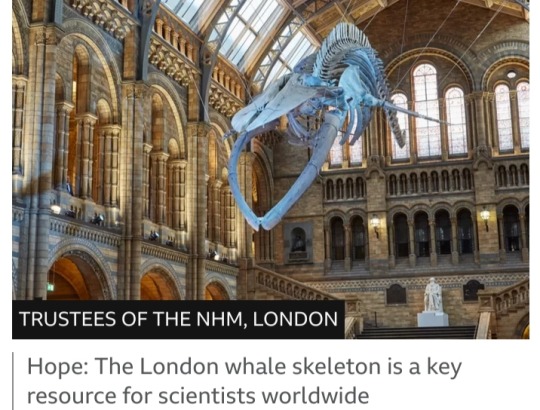
In life, Perucetus' skeletal mass would have been two to three times that of Hope, even though the London mammal was a good five metres longer.
Richard Sabin, the curator of marine mammals at the NHM, is thrilled by the new find and would love to bring some aspect of it to London for display.
"We took the time to digitise Hope - to measure not just the weight of the bones but their shape as well, and our whale has now become something of a touchstone for people," he said.
"We don't get hung up on labels - like 'which was the largest specimen?' - because we know science at some point will always come along with new data.
What's amazing about Perucetus is that it demonstrated so much mass some 30 million-plus years ago when we thought gigantism occurred in whales only 4.5 million years ago."
Perucetus colossus is reported in the journal Nature.
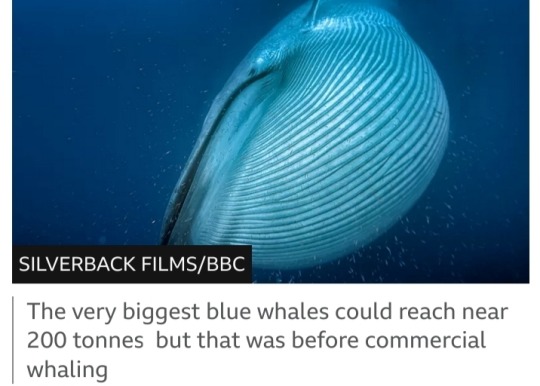
#Perucetus colossus#Perucetus#Peru#fossils#palaeontology#whale#basilosaurid#osteosclerosis#pachyostosis#Royal Belgian Institute of Natural Sciences#long-extinct species#State Museum of Natural History Stuttgart#blue whale#Natural History Museum#Hope#Peruvian fossil
23 notes
·
View notes
Text
Two PNW tribal nations sue oil companies over costs of climate change
https://www.seattletimes.com/seattle-news/environment/two-pnw-tribal-nations-sue-oil-companies-over-costs-of-climate-change/
Major oil companies for decades deliberately sought to downplay and discredit scientific warnings about the central role of fossil fuels in causing climate change, alleges two lawsuits filed this week by the Makah and Shoalwater Bay tribes.
The lawsuits filed in King County Superior Court name ExxonMobil, BP, Shell, Chevron, ConocoPhillips and Phillips 66 as defendants, and seek compensation for the millions of dollars already spent, and likely to be spent in the future, for the tribes to respond to climate-induced disasters such as extreme heat, drought, wildfire, shoreline erosion, sea level rise and flooding.
The lawsuits allege the companies have known fossil fuels would cause catastrophic climate change since at least 1959, but continued marketing massive quantities of oil and gas. They allege the oil companies tried to mislead the public by funding op-eds and advertisements in Seattle and national newspapers that claimed the science of climate change was uncertain or lacking evidence.
The complaints outline the companies’ research and misleading marketing around their products’ role in causing climate change and the sea level rise, extreme weather, public health harms and other climate effects on the tribes and their lands.
With both the Makah and Shoalwater Bay reservations on the Pacific Ocean, they are particularly vulnerable to sea level rise, the lawsuits state. Both tribes have already incurred the costs of moving their citizens to higher ground, and ocean acidification “at an alarming rate” from burning fossil fuels has endangered the tribes’ coastal ecosystems and economy, according to the lawsuits.
“We are seeing the effects of the climate crisis on our people, our land, and our resources. The costs and consequences to us are overwhelming,” said Makah Tribal Council Chair Timothy J. Greene, Sr. in a statement. “We intend to hold these companies accountable for hiding the truth about climate change and the effects of burning fossil fuels. And we aim to force them to help pay for the high costs of surviving the catastrophe caused by the climate crisis.”
The lawsuits also cite a report by the Climate Impacts Group at the University of Washington that suggests with global warming of at least 1.5 degrees Celsius by 2050, Washington is projected to experience a 67% increase in the number of days per year above 90 degrees, relative to 1976-2005, leading to an increased risk of heat-related illness and death, warmer streams and more frequent algal blooms.
The report also found warming would fuel a decrease of 38% in snowpack, relative to 1970-99, leading to reduced water storage, irrigation shortages, and winter and summer recreation losses, as well as increases in winter streamflow, decreases in summer streamflow, leading to reduced summer hydropower, conflicts over water resources and negative effects on salmon.
“These oil companies knew their products were dangerous, yet they did nothing to mitigate those dangers or warn any of us about them, for decades,” said Shoalwater Bay Chair Charlene Nelson in a written statement. “Now we are facing hundreds of millions of dollars in costs to relocate our community to higher ground and protect our people, our property, and our heritage. These companies need to be held accountable for that.”
The tribes bring their claims under Washington’s Products Liability Act for failure to warn, misrepresentation and intentional concealment. The complaints request jury trials, and ask the court to order the companies to create a fund to be managed by the tribes to remediate and adapt reservation lands, natural resources and infrastructure to climate change.
#Washington state#makah#shoalwater bay tribe#climate change#fossil fuels#environment#indigenous activism
12 notes
·
View notes
